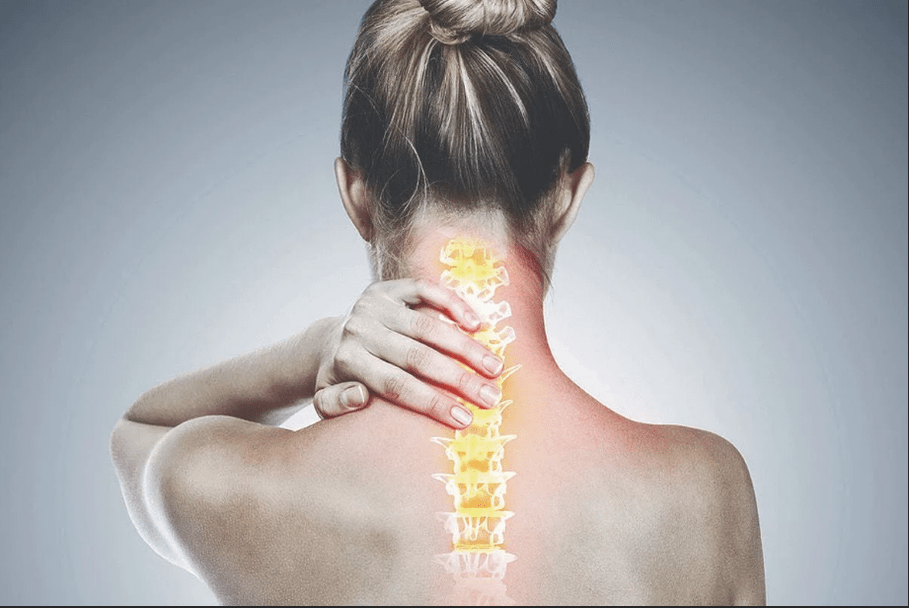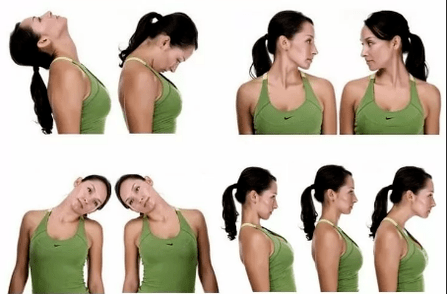Cervical osteocondrosis is the progressive dystrophic and deigenerative lesion of the intervertebral discs in the range 1-7 vertebrae belonging to the cervical region.

As a result of cervical osteocondrosis occurs deformation, fatigue and then damage to the spines.This interferes with normal blood supply and nervous conductivity in the neck and in the areas that are inner by the roots of the nerves of the cervical nerves.
Cervical osteocondrosis can either be isolated or combined with osteocondrosis of other parts - breast, lumbar and sacral.
Causes
The causes of dystrophic and degenerative changes in the intervertebral disks have not yet been investigated adequately.The assumption that osteocondrosis is a senior phenomenon with confirmation.It is found even in children and young people.
A number of factors that dispose of the development of osteocondrosis are distinguished.These include:
- Sedomes and sedentary lifestyle,
- Sitting types of work with a static load on the neck,
- Overweight, inadequate physical development,
- dysplastic processes with connective tissue,
- Violation of blood circulation in the neck,
- Neck injury,
- Scoliosis, body defects, unpleasant pillows and mattresses,
- Hereditary disposal, metabolic defects.
Symptoms of cervical osteocondrosis
The spine of the liver due to the functions of the skeleton, straightforward, as well as due to the large size of the head, is especially vulnerable to the development of osteocondrosis rhythmic in it is the smallest compared to other parts of the spine, and the muscle frame is not very pronounced.
The most distinctive symptom that patients complain about - pain in the cervical region.Depending on the injury zone, the pain may be located
- in the collar and shoulder;
- Throughout cervical spine;
- On the front surface of the chest.
Pain for cervical osteocondrosis is due to the functions of the cervical region.
The first signs of cervical osteocondrosis are insignificant and slightly specific:
- The pain in the neck in the evening,
- Feeling of heaviness in the head, headache in the occipital zone,
- a feeling of numbness or tingling in the shoulders and hands,
- The crystal in the neck as you turn your head, click on the vertebrae.
Leading Symptoms:
Vegetative-dystonic
- Quite severe pain in the neck and especially in the area just below the back of the head;
- Pain occurs after a long stay in a position (for example, after sleep);
- The neck muscles are constantly tense;
- There are difficulties in giving up the hand to the side;
- On the affected side, the fingers are limited in movements.
As the spines are compressed, neurological manifestations are observed: headaches, nausea, fainting.
Spinal cord symptom
Pain is located behind the sternum to the left.
This type of pain should be distinguished from pain in angina pectoris (with angina pectoris, nitroglycerin is relieved with osteocondrosis - no).
With a gradual violation of the structure of the intervertebral disks, their compression (compression) occurs and violation of the roots of the nerve, as well as narrowing or violation of arteries and veins that occur in the area with the spine.
This leads to the formation of special syndromes - radicular and ischemic.
- The defeat of the roots of the first cervical vertebra (C1): violations affect the back of the head, reducing skin sensitivity;
- Lesion C2 causes pain in the crown of the crown and back of the head;
- The lesion of C3 causes pain in the neck from the side of violation, a decrease in sensitivity in the tongue and sub -language muscles, in some cases of speech inhibition and loss of control over the language;
- The defeat of C4 and C5 causes pain in the shoulder and clavicle, a decrease in the tone of the muscles of the head and neck, hiccups, airway disorders and pain in the heart;
- Defeat C6 is most often, causing pain from neck to the shoulder blade, forearm, up to the thumb, the skin sensitivity likes:
- The defeat C7 causes similar symptoms with pain in the neck, the back of the shoulder, up to the back of the hand, violation of the strength of the hands and a decrease in reflexes.
Blood circulation disorders due to the compression of the vessels in the area with the cervical vertebrae cause headaches up to migraines, severe dizziness, visual impairment and ears in the ears, flickering flies in front of the eyes, disorders of autonomous functions.
There may be manifestations of heart syndrome with pressure pain, lack of air and heartbeat, rhythm disorders.
Complications
Serious complications of cervical osteocondrosis are
- projection of intervertebral discs with the formation of a hernia (protrusion);
- Rupture of the intervertebral disk with violation of nerves and blood vessels, compression of the spinal cord is possible, which can lead to death;
- There may also be radiculopathies (lesions of roots), the formation of osteophytes (spikes on the vertebrae) with a manifestation of palsy and paralysis.
Diagnostics

In the presence of the above complaints, an appeal to the orthopedic doctor or neurologist is necessary.
First of all, the doctor will evaluate mobility and tenderness in the neck, sensitivity and other functions.Subsequently, radiography of cervical spine is required in multiple projections if necessary computed tomography or magnetic resonance scan on suspicion of hernia.
In case of circulatory disorders, rheoencephalography and examination of the fundus are needed.
Treatment of cervical osteocondrosis
The same symptoms may be indicative of various diseases and the disease may not occur according to the textbook.Don't try to be treated yourself - see your doctor.
Today, there are both traditional and non -traditional methods of treating osteocondrosis in cervical spine.
Conservative methods are used mainly:
- Symptomatic therapy with painkillers (Baralgin, Analin) to relieve pain syndrome
- To take anti -inflammatory drugs from non -steroidal series (diclofenac, indomethacin, meloxicam) -to relieve inflammation and edema of tissues
- To eliminate muscle cramps, antispasmodics -no -shpu, drugs are used to improve blood circulation -Trental.
In the treatment of cervical osteocondrosis, substances are used that restore the structure of the intervertebral disks - Theflex.
The course of vitamin treatment of group B is shown, the external products for therapy are useful - gels and ointments, creams with anti -inflammatory, heating and painkillers - the voltar.The stimulants for regenerating the intervertebral discs are shown - Teraflex or Chondroxide.
When treating cervical osteocondrosis, the wear of a special collar (Shantsa collar) is recommended.
Complications of cervical osteocondrosis with between spines that violate sensitivity and blood circulation can be treated immediately.
The duration of treatment depends on the neglect of the condition as osteochondrosis is a progressive chronic disease.Treatment can be long and preventive courses are performed for life.
Proper nutrition will help relieve the condition of osteochondrosis.Read more about the principles of diet for osteochondrosis in our separate article.
Exercises for the treatment of cervical osteocondrosis:

- The actual traction: In a position with one right back, it is necessary to lower the shoulders as low as possible while the neck needs to be pulled up.It is necessary to make at least 10 approaches at least 3 times a day.
- Self -massage: grace the neck with a towel, takes it at the ends and pulls it alternately for them and spreads the muscles of the neck.In this case, it is necessary to ensure that the towel does not slip along the neck.
- Gymnastics for the cervical region for osteocondrosis: Small bending of the neck as well as swing and slope of the head are shown.At one point, 5-7 inclinations are made in each direction.This exercise is most useful for performing after self massage of cervical spine.
Prevention
The foundation of cervical spine is a strong and healthy back, physical activity, a comfortable bed with anatomical pillows and mattress, proper posture and proper nutrition.
It is worth avoiding neck damage and weightlifting.It is necessary to combine prolonged sitting with periods of rest and warm -up.




























